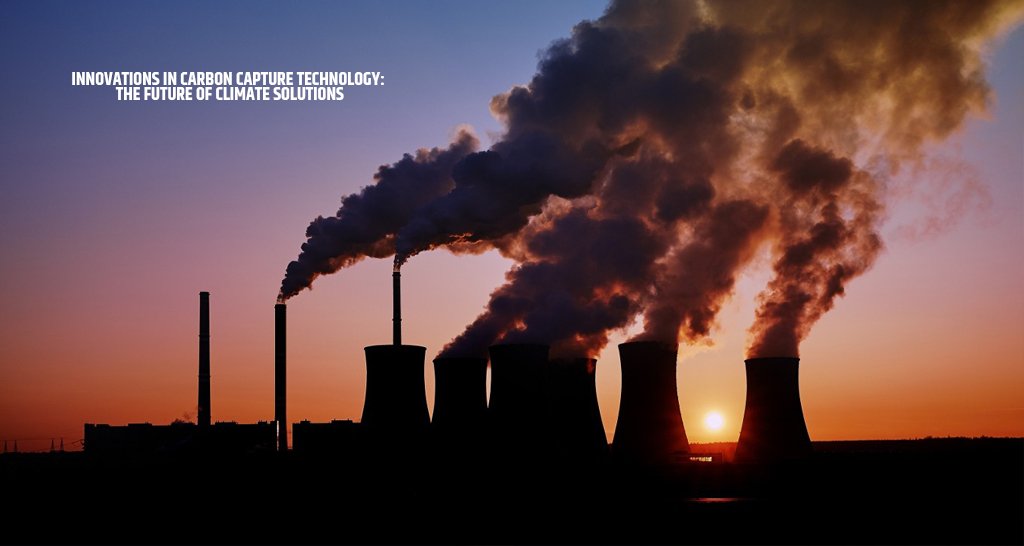Introduction to Carbon Capture Technology
Carbon capture technology refers to a range of methods and processes designed to capture carbon dioxide (CO2) emissions produced from industrial activities before they can reach the atmosphere. By preventing CO2 from entering the air, this technology plays a vital role in the fight against climate change, helping to mitigate the adverse effects of greenhouse gas emissions that are contributing to global warming.
The significance of this technology cannot be overstated. As countries around the world strive to meet ambitious climate goals set forth in international agreements like the Paris Accord, the demand for effective carbon reduction strategies is increasingly critical. Carbon capture not only addresses emissions from fossil fuel-based power plants but also has applications across various sectors, including cement, steel, and chemical production, where substantial CO2 emissions occur. Integrating carbon capture processes has the potential to significantly diminish the carbon footprint of these industries, making it an essential component of a broader decarbonization strategy.
The development of carbon capture technology has roots dating back several decades. Early research focused on capturing CO2 in specific industrial contexts, gradually leading to pilot projects and commercial applications. The initial approaches largely examined absorption techniques, and over time, advancements in materials and processes have enhanced efficiency and reduced costs. Innovations like membrane technologies, cryogenic separation, and adsorption processes have emerged, each contributing to the evolution of carbon capture methodologies. As awareness of climate issues has intensified, investment in research and development has surged, fostering the evolution of more sophisticated carbon capture systems that promise not only to reduce emissions but also to utilize captured CO2 for beneficial purposes, such as enhanced oil recovery or chemical production.
How Carbon Capture Works
Carbon capture technology is a crucial innovation aimed at reducing atmospheric carbon dioxide (CO2) levels, thereby mitigating climate change. This process involves capturing CO2 emissions from various sources, particularly industrial facilities and power plants, before they can reach the atmosphere. The captured carbon can then be stored or utilized in various applications, making it a versatile solution in the fight against global warming.
One of the primary methods of capturing carbon is absorption, which involves a chemical reaction between CO2 and a solvent, typically amines. In this system, flue gas containing CO2 is passed through a liquid absorbent, allowing the CO2 to dissolve and form a compound with the solvent. The absorbed CO2 can later be released by heating the solvent, which provides a mechanism for collecting the gas for storage or reuse.
Another effective method is adsorption, which utilizes solid materials, known as adsorbents, to attract and bind CO2 molecules. This technique relies on physical or chemical interactions between the adsorbent and the CO2, allowing for the separation of the gas from other emissions. Common adsorbents include activated carbon and zeolites, which possess high surface areas and porosity, enhancing their efficiency in capturing carbon dioxide.
Membrane separation is another innovative approach to carbon capture, utilizing selective permeable membranes to separate CO2 from other gases. This method relies on differences in gas diffusion rates, allowing CO2 to pass through the membrane while retaining other gases. Membrane technology is gaining attention due to its low energy requirements and potential for modular design, which could lead to scalable solutions in various industrial settings.
Each of these techniques contributes significantly to the overall efficiency of carbon capture, enabling industries to reduce their greenhouse gas emissions. By integrating these processes into their operations, companies can play a vital role in combating climate change and moving towards a more sustainable future.
Recent Technological Innovations
The realm of carbon capture technology has witnessed significant advancements in recent years, leading to enhanced capabilities in mitigating greenhouse gas emissions. One of the most promising innovations is direct air capture (DAC), a process that removes carbon dioxide directly from the atmosphere rather than from industrial emissions. These systems employ a variety of chemical processes, notably sorbent materials that selectively bind CO2, enabling a more efficient extraction. Enhanced DAC technologies have been developed to increase their efficiency while simultaneously reducing costs, aiming for greater scalability and deployment in diverse environments.
Among the noteworthy materials, novel sorbents are emerging as vital components in the carbon capture spectrum. These materials are engineered to possess higher adsorption capacities and faster kinetics compared to traditional options. Additionally, the use of metal-organic frameworks (MOFs) has garnered attention, as these structures can provide an expansive surface area for CO2 absorption while maintaining structural stability over extended periods. Innovations in these sorbent materials not only improve the performance of carbon capture systems but also facilitate their integration into existing industrial processes, heightening the potential for industrial symbiosis.
In addition to breakthroughs in sorbents, advancements in chemical processes further bolster the efficacy of carbon capture technology. Enhanced techniques, such as advanced membrane filtration and solvent regeneration methods, have been designed to minimize energy consumption and maximize carbon removal rates. Research is actively focused on refining these processes to achieve lower operating costs, thereby unlocking the potential for widespread adoption in various sectors, particularly in energy-intensive industries.
Overall, these recent technological innovations mark a substantial progression in carbon capture technology, paving the way for more effective climate solutions. The interplay between novel materials and advanced processes symbolizes a significant leap forward in our efforts to combat climate change and transition to a sustainable future.
Prominent Carbon Capture Projects Worldwide
Across the globe, several innovative carbon capture projects have emerged, showcasing the potential of this technology in mitigating climate change. One of the most recognized initiatives is the Norwegian project at Sleipner, which has been operational since 1996. This offshore facility captures approximately 1 million tonnes of CO2 annually from natural gas production, employing a patented amine-based separation process. The captured carbon is then stored deep under the North Sea, demonstrating both the feasibility and safety of long-term CO2 storage.
In Canada, the Boundary Dam project stands as a key example of integrating carbon capture technology into existing infrastructure. Launched in 2014 in Saskatchewan, this facility retrofitted a coal-fired power plant with a carbon capture system that can capture up to 1 million tonnes of CO2 yearly. The project not only reduces greenhouse gas emissions but also generates revenue by selling the captured CO2 for enhanced oil recovery. This case highlights the economic viability of carbon capture when paired with traditional energy production methods.
The United States is also home to several promising carbon capture initiatives. One notable project is the Petra Nova project, which began operation in 2017 in Texas. This facility captures CO2 from a coal plant and aims to reduce emissions by 1.6 million tonnes per year. The carbon dioxide captured is utilized in oil recovery operations, providing a dual benefit of reducing emissions while enhancing energy extraction. Projects like Petra Nova showcase the potential for carbon capture technologies to be integrated with fossil fuel operations, paving the way for a transition towards cleaner energy sources.
These prominent carbon capture projects serve not only as successful models for reducing atmospheric CO2 levels but also as demonstrations of the technology’s adaptability across various industries and regions. Their achievements provide valuable insights into replicable strategies that can be implemented worldwide to combat climate change effectively.
Challenges and Barriers to Adoption
The advancement of carbon capture technology is pivotal for addressing climate change, yet its widespread adoption faces several significant challenges. One of the foremost obstacles is economic. The initial investment required for developing and implementing carbon capture solutions can be substantial. The high cost of capture technology, combined with the need for infrastructure reconstruction, presents a financial burden that many companies and governments are reluctant to bear. In addition, the market for carbon credits remains unstable, leading to uncertainties about long-term profitability and diminishing incentives for businesses to invest in carbon capture systems.
Technological limitations also hinder the progress of carbon capture implementations. While advancements have been made, existing methods still vary significantly in efficiency and applicability. Many carbon capture technologies are only feasible for large-scale emitters, such as power plants and industrial facilities, which restricts their use across various sectors, including transportation and agriculture. Moreover, the need for substantial research and development to improve the efficacy of capture technologies cannot be overstated, as many existing methods produce only a fraction of what is required to meet carbon reduction goals.
Regulatory hurdles play a crucial role in stifling the adoption of carbon capture technology. The lack of clear and consistent policies can deter investment, as stakeholders may be hesitant to commit resources amidst regulatory uncertainty. Furthermore, environmental regulations can sometimes create conflicts with carbon capture initiatives, particularly when it comes to land use and resource allocation. Public perception also influences the acceptance of carbon capture projects. Community concerns regarding safety, environmental impact, and the perceived effectiveness of these technologies can lead to resistance and opposition to proposed projects. Thus, addressing these multifaceted challenges is essential for the successful integration of carbon capture technologies into our climate solutions. In conclusion, overcoming the economic, technological, regulatory, and perceptual barriers is critical for realizing the full potential of carbon capture in combating climate change.
Future Directions in Carbon Capture Research
The future of carbon capture technology is poised to undergo significant advancements, primarily driven by research initiatives aimed at addressing existing challenges. One promising direction involves the development of innovative materials to enhance carbon capture efficiency. Researchers are investigating various absorbent substances, including metal-organic frameworks (MOFs) and advanced polymers, which have demonstrated potential in selectively capturing carbon dioxide (CO2) from the atmosphere or emissions. These materials can improve the economics of carbon capture systems by reducing energy consumption associated with CO2 removal processes.
Another critical area of research focuses on the integration of carbon capture technologies with renewable energy sources. By coupling carbon capture systems with renewable energy, researchers aim to reduce the operational costs and environmental impact of these technologies. For example, using solar energy to power carbon capture processes could enable facilities to operate with lower carbon footprints, ultimately making the capture of CO2 more sustainable and scalable. This integration is essential for creating a resilient clean energy ecosystem, where carbon capture plays a vital role in mitigating climate change.
Furthermore, advancements in policy support are crucial for fostering research and development efforts in carbon capture technology. Governments and institutions worldwide are recognizing the urgency of climate action, resulting in increased funding opportunities and collaborative initiatives aimed at promoting innovation. Policies that encourage research initiatives and provide incentives for advancements in carbon capture can serve to streamline development timelines, facilitating faster deployment of these technologies across various sectors.
In conclusion, the future of carbon capture research is promising, as ongoing initiatives aim to improve materials, integrate renewable energy sources, and enhance policy frameworks. These efforts are vital for overcoming current limitations, ultimately contributing to the broader goal of reducing atmospheric CO2 levels and combatting climate change effectively.
The Role of Carbon Capture in Climate Policy
Carbon capture technology plays a critical role in shaping climate policy at both international and national levels. As the world grapples with the challenges posed by climate change, leaders and policymakers are increasingly acknowledging that achieving net-zero greenhouse gas emissions cannot be accomplished solely through renewable energy sources. Instead, integrating carbon capture, utilization, and storage (CCUS) into climate strategies has emerged as an essential component of comprehensive climate action frameworks, such as the Paris Agreement.
The Paris Agreement, adopted in 2015, sets a global framework for combating climate change by limiting global warming to well below 2 degrees Celsius above pre-industrial levels. It encourages nations to outline their individual contributions to reducing emissions, often referred to as Nationally Determined Contributions (NDCs). Many countries recognize carbon capture as a pivotal technology capable of reducing emissions from hard-to-abate sectors, such as cement, steel, and fossil fuel energy production. By incorporating carbon capture into their NDCs, nations can effectively demonstrate their commitment to climate goals while simultaneously advancing technological innovation.
At the national level, governments are also beginning to prioritize carbon capture in their climate action plans. Countries such as the United States and the United Kingdom are providing funding and incentives for research and development in carbon capture technologies. These initiatives aim to enhance the feasibility and scalability of CCUS, ultimately leading to broader adoption within various industrial processes. By considering carbon capture not just as an add-on solution but as a fundamental strategy in national climate frameworks, governments are positioning themselves to meet both current and future emission reduction targets effectively.
In conclusion, the integration of carbon capture technology into global and national climate policy frameworks underscores its importance as a strategic tool in addressing the urgent crisis of climate change. As nations continue to refine their climate commitments, the role of carbon capture will likely expand, offering a path toward achieving meaningful reductions in greenhouse gas emissions.
Economic Impacts and Opportunities
The adoption of carbon capture technology heralds significant economic implications, particularly in the realms of job creation, investment opportunities, and the financial viability of scaling such operations. As industries and governments increasingly recognize the importance of reducing carbon emissions, investing in carbon capture, utilization, and storage (CCUS) systems holds promise for not only mitigating climate change but also bolstering economic growth.
One of the foremost economic benefits of carbon capture technology lies in job creation. The implementation of CCUS projects requires a skilled workforce across various fields, including engineering, manufacturing, and environmental science. The expansion of the carbon capture industry could lead to tens of thousands of new jobs globally, particularly in regions reliant on fossil fuel industries. Furthermore, as existing energy infrastructures pivot towards more sustainable approaches, this transition can stimulate opportunities in retraining and upskilling workers, ensuring they are equipped for roles in a green economy.
Investment in carbon capture technology is also a significant opportunity for economic growth. Public and private sectors are increasingly channeling funds into research and development of innovative CCUS solutions. Companies that specialize in advancing these technologies are finding a receptive market, prompting increased investment in related sectors. This influx of capital not only supports technological advancement but can also create economic partnerships between businesses and governments focused on sustainable practices.
In addition, the financial viability of scaling carbon capture operations is increasingly becoming evident as technology matures. Innovative approaches, coupled with declining costs, may facilitate broader deployment across various industries. As carbon pricing mechanisms and regulatory frameworks evolve, organizations that implement carbon capture can benefit economically through carbon credit trading and compliance with emissions reduction mandates.
Overall, the economic implications and opportunities presented by carbon capture technology are numerous, contributing to a sustainable economy while addressing the pressing challenges of climate change.
Conclusion: The Path Forward for Carbon Capture
As we navigate the challenges posed by climate change, carbon capture technology emerges as a critical component in our arsenal of climate solutions. Throughout this discussion, we have explored various innovations within the field, highlighting not only the technological advancements but also the pivotal role that these developments play in reducing greenhouse gas emissions. Carbon capture is no longer a distant possibility; rather, it is an achievable goal that requires the concerted efforts of governments, private sectors, and academia.
Investment in carbon capture technology is essential for its maturation and widespread implementation. Scaling these innovations will necessitate significant funding and resources to facilitate research, development, and deployment. Partnerships across various sectors can enhance this process, allowing for knowledge sharing and the pooling of resources to overcome the current limitations faced in widespread adoption. Collaborative efforts can also drive policy change to support carbon capture initiatives, ensuring that they are integrated into national and international climate strategies.
Additionally, public awareness and acceptance play a vital role in the growth of carbon capture solutions. Educating communities about the benefits and operational mechanics of these technologies can help mitigate public concern and foster a supportive environment. By communicating the long-term advantages of carbon capture, including its potential to create jobs and drive economic growth alongside environmental sustainability, stakeholders can cultivate a more positive perspective on climate intervention measures.
In summary, the path forward for carbon capture technology is laden with potential, contingent upon ongoing innovation, robust investment, and cohesive collaboration among all stakeholders involved. By prioritizing these elements, we can harness the full capacity of carbon capture and make significant strides toward our climate goals, paving the way for a healthier planet for future generations.



